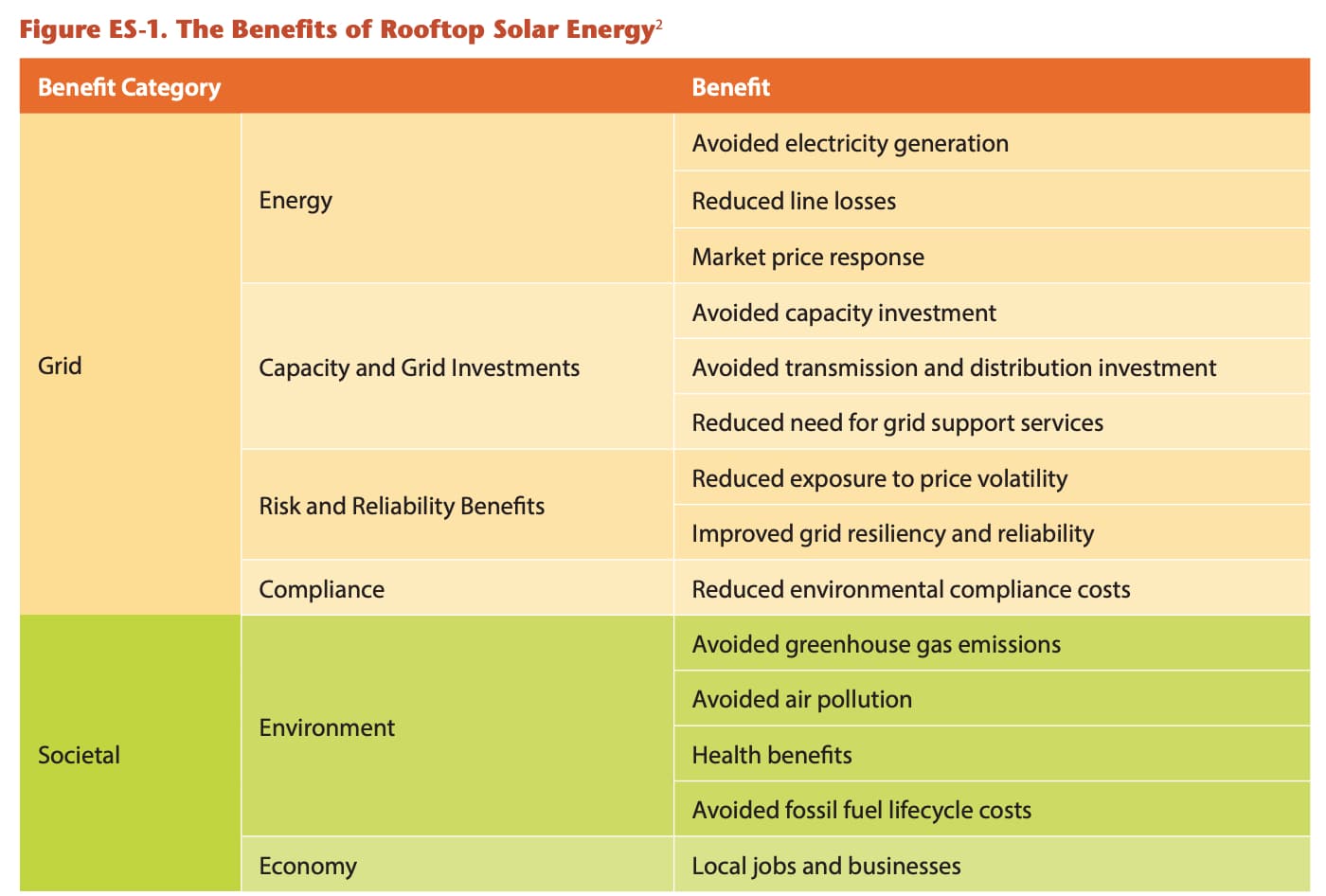Environment Texas Research and Policy Center and Frontier Group have released a report: The True Value of Solar: Measuring The Benefits of Rooftop Solar Power, which calls on the Public Utility Commission of Texas (TPUC) to promote solar more actively than it does and has, with a focus on rooftop solar. The study recognizes that, for most, the previously recognized benefits of solar have begun and ended at renewable energy, and by analyzing the full scope of benefits that customer-sited solar brings to citizens, the grid and communities at large, more effective policies promoting solar will be put into place.
The report summarizes its conclusions in a flowchart-style graph split initially between grid and societal benefits:

While both sections both sections detail critical benefits of rooftop solar, the societal section feels more straightforward. It reiterates the common recognized arguments for solar, including probably the most popular societal arguments for: avoided greenhouse gas emissions, avoided air pollution and job creation.
What’s really interesting about the chart is the grid benefits section. As we’ve long said, utilities have consistently opposed the growth of distributed solar. What this first section is, considering this report is addressing the TPUC, is essentially an appeal in support of distributed before the regulator of its biggest hindrance.
While not the only one, the paramount reason that utilities are at odds with distributed solar is simply because it cuts into their revenues. The report argues, however, the avoided costs created by promoting and investing in distributed solar outweigh these considerations. Potentially the biggest single avoided costs are the avoided electricity costs, whether that be from owning generation assets or purchasing power. This is most seen in the summer, when demand is highest and electricity is at its most expensive. Instead of losing money by running inefficient generators or purchasing wholesale, solar can ease demand seamlessly, as this period is also the time of peak solar generation.
Another interesting point is the last one made, distributed solar’s benefit via avoided environmental compliance costs. Instead of investing in new renewable generation and pollution control measures, the cost of those requirements can essentially be sent over to the consumer. The argument is that the avoided cost of not having to build new generation is greater than the cost of the power purchased from a person’s home solar system, with the purchase of this energy being necessary to claim those systems to be a portion of the utility’s generation portfolio.
What will be most interesting from here on out is if/how well this report is received by TPUC. The cynic wants to say that it won’t be, but money talks. Texas has been on a utility-scale solar development rampage lately and those projects do not come cheap. If Texas were to decide to value the avoided cost of distributed solar and the benefits it provides, we could see a true revolution in how the power system treats self generation – including utilities.
This content is protected by copyright and may not be reused. If you want to cooperate with us and would like to reuse some of our content, please contact: editors@pv-magazine.com.








The avoided capacity and grid investments are huge as well. And with solar+storage this is about doubled.
“While not the only one, the paramount reason that utilities are at odds with distributed solar is simply because it cuts into their revenues.”
These rote electric utilities don’t know HOW to make money with anything that the utility itself doesn’t own. Even with solar PV and wind generation, the utility wants to ‘own’ the generation asset. They want to control the grid as a unidirectional entity to their benefit.
” If Texas were to decide to value the avoided cost of distributed solar and the benefits it provides, we could see a true revolution in how the power system treats self generation – including utilities.”
Distributed solar PV with behind the meter energy storage, represents a very large avoided cost for the utility. The utility has non-fueled generation distributed along the grid, the energy storage can more effectively use the solar PV over generation for after hours to help remediate the “duck curve”. The aggregate storage of thousands of BTM energy storage systems can be used as arbitrage by the utility at night during off peak power pricing.
The biggest benefit for many is that when the grid is down (assuming you buy a system configured for it) you can run off grid until the outage is over. This means you can keep your food from rotting, use your lights and TV and probably internet. In winter, you could run your gas or oil furnace. If you configure with battery backup, you may not even notice the outage.